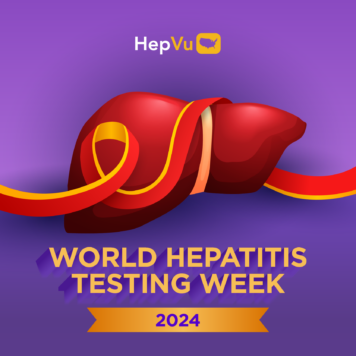Q: Your postdoctoral research focus is on infectious disease epidemiology, such as Hepatitis C. What led you to this focus?
I’ve always been a “numbers” person who is drawn to data and statistics. I view epidemiology as an opportunity to utilize population data and statistics to better understand the various factors that influence health outcomes. My specialization in infectious diseases arose from a combination of my interest in quantitative analytic methods and the recognition that infectious diseases are currently very important public health priorities in the U.S. Infectious disease research is interesting and complicated because a person’s risk of disease involves both their own risk factors and the risk factors of their personal contacts.
One of the main public health challenges for infectious diseases is that while we often know how to prevent transmission from one person to another in theory, the challenge is to identify when, where, and how to deliver acceptable and effective interventions. We see that with Hepatitis C in the U.S. Despite having a variety of prevention strategies and curative treatments, Hepatitis C is still a huge problem in our country. Before the COVID-19 pandemic, Hepatitis C was responsible for more deaths in the U.S. than all other infectious diseases combined. Hepatitis C elimination is an important goal for the U.S., and research conducted by epidemiologists and other public health specialists can help to inform and guide that process.
Q: Your new paper, “County-Level Variation in Hepatitis C Virus Mortality and Trends in the United States, 2005-2017,” concluded that despite the overall decrease in Hepatitis C related mortality rates across U.S. counties, the “magnitude and composition” of that decline has varied dramatically among different regions. What regions are disproportionately impacted and what potential factors might explain these differences?
Across the country, Hepatitis C-related mortality, which are deaths attributable to the Hepatitis C virus, has been decreasing since about 2013 and there are a few possible explanations for this decline. First, the highest burden of Hepatitis C infections is among people born between 1945 and 1965, so called “Baby Boomers”. As this group continues to age and pass away, we would expect Hepatitis C-related death rates to also fall. Second, curative treatments – direct-acting antiviral agents (DAAs) – were introduced in 2011 and expanding access to these treatments would be expected to reduce Hepatitis C-related mortality rates as more people are cured of their chronic infections.
In this analysis, we found a recent decline in Hepatitis C-related mortality in the U.S. on average, but the change in Hepatitis C varied across regions. In some counties, Hepatitis C-related mortality declined less than the national average decline we observed. And most concerning, out of the 2,839 counties with reliable trend estimates, 565 counties showed an increase in Hepatitis C-related mortality rates between 2013 and 2017, which approximately one in five counties.
The counties found to have increasing Hepatitis C-related mortality rates were disproportionately concentrated in parts of the Southwest, such as Oklahoma and Texas, as well as in Appalachia. In this paper, we did not attempt to explain the reasons for these regional differences in mortality but rather, described them to highlight a lack of health equity in areas that need to prioritize the identification of viral hepatitis infections and expand interventions that can reduce mortality such as screening and curative treatments.
Q: Your analysis stratified county-level Hepatitis C-related mortality data by age. Could you expand on key trends from this analysis and what they suggest about disparities in Hepatitis C outcomes?
In this paper, we estimated Hepatitis C-related death rates for two age groups: adults younger than 40 years of age, and adults older than 40 years of age. As one might expect, Hepatitis C-related mortality is generally much higher in the older age group, and the bulk of Hepatitis C-related deaths are occurring in this older group.
However, we also observed that Hepatitis C-related mortality in several places around the country is increasing among adults younger than 40 years of age. Many of the counties with the highest death rates for this younger age group are concentrated again in Appalachia and parts of the Southwest. These areas have also experienced increases in injection drug use (IDU) and rising viral hepatitis incidence rates.
We did not estimate Hepatitis C-related death rates by sex or race, but the modeling framework that we used could potentially be expanded to include those stratifications and would be a great next step for this work, especially given disparities by race and sex in Hepatitis C incidence, prevalence, and treatment access.
Q: How can data at finer geographic levels, such as at the county-level, help policymakers, public health officials, and community-based organizations better understand and address the Hepatitis C epidemic in the U.S.?
In public health, we often look at national- and state-level data to guide policy decisions and evaluate trends. It’s important to recognize that national- or state-level data is an average of what’s occurring in smaller geographic areas, such as counties. While national- and state-level data are important because they provide a high-level perspective of disease burden and trends, they can also mask differences or disparities that might be occurring at local levels.
Removing that mask and uncovering those differences gives us a more detailed understanding of the viral hepatitis epidemic across the country. This detailed picture is important in determining where to allocate funding and resources to reduce Hepatitis C-related mortality.
Many public health initiatives are implemented by county or local health departments. Those jurisdictions can use these data to better understand how Hepatitis C-related mortality in their region compares to surrounding areas or to the nation as a whole.
Q: The recently released U.S. Department of Health and Human Services (HHS) and the Centers for Disease Control and Prevention (CDC)’s national strategic plans for viral hepatitis elimination call for critical improvements in viral hepatitis surveillance funding and infrastructure. How can your data help stakeholders working to eliminate Hepatitis C in the U.S.?
There is an essential need to improve surveillance infrastructure to track the basic key metrics of viral hepatitis. In order to understand any epidemic, we need systematic, accurate, and timely estimates of prevalence, incidence, and mortality. These are not only essential data points for understanding the burden of any health condition on populations but are also indicators that we can use to track progress towards elimination efforts.
Currently, there are limited data on Hepatitis C prevalence, incidence, and mortality in the U.S. New Hepatitis C infections are reported to CDC’s National Notifiable Disease Surveillance System, but differences in state laboratory testing requirements and applications of case definitions, as well as the lack of surveillance resources, leads to inconsistent data across jurisdictions.
Our best estimates of Hepatitis C prevalence are based on large national survey samples that sometimes don’t include high-risk groups or have long delays between survey cycles. On HepVu, there is data on national and state-level Hepatitis C-related death rates, but Hepatitis C-related mortality is not regularly estimated and presented for smaller geographic areas.
I want to emphasize the importance of Hepatitis C-related mortality rates as an indicator towards viral hepatitis elimination by pointing to CDC’s Division of Viral Hepatitis 2025 Strategic Plan. One of the main goals of the plan is to reduce viral hepatitis-related morbidity and mortality, including reducing Hepatitis C-related death rates to less than three per 100,000 by 2023 and reducing national annual age-adjusted Hepatitis C-related death rates. In the paper, we reported that 30% of counties (854 out of 2,839 counties) met this goal of Hepatitis C-death rates at or below three per 100,000 populations. This data can help identify areas that are currently meeting these goals or areas where additional work needs to be done.
Although the county-level data in this paper add to our understanding of the viral hepatitis landscape, they do not replace the need for an improved, comprehensive, and cohesive viral hepatitis surveillance system in the U.S.



